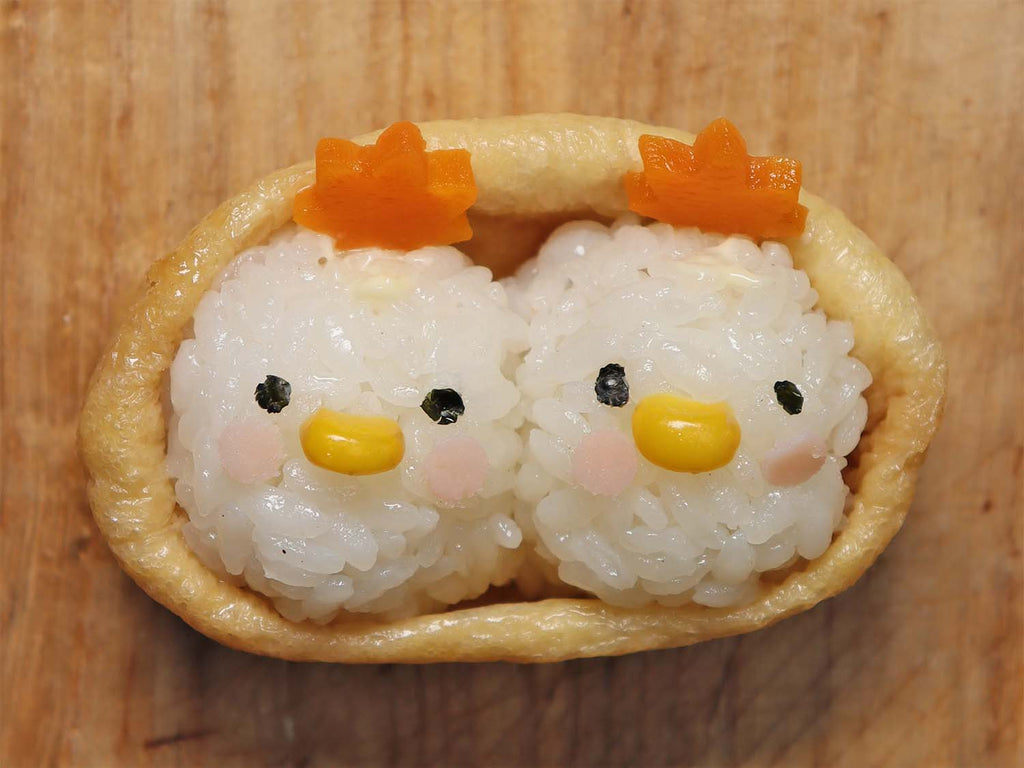Inari sushi is a type of sushi made by filling vinegared rice into deep-fried tofu pouches that have been simmered in a sweet and savory sauce. It’s also known as Oinari-san or simply Oinari in Japanese.
Unlike other types of sushi, the classic version of inari sushi doesn’t contain raw fish, making it a great option for those who aren’t fond of raw seafood or for children.
In Japan, inari sushi is commonly enjoyed in lunchboxes, at picnics, or during home parties, since it’s easy to eat with your hands.
In this recipe, we’ll show you how to make the classic version of inari sushi, along with two creative variations: Open Inari, topped with colorful ingredients, and Deco Inari, cutely decorated to look like characters or animals.
Have fun making them!
Table of Contents
- The Story Behind This Recipe
- How to Make Classic Inari Sushi
- How to Make Open Inari with Soboro (Flavored Ground Chicken)
- How to Make Open Inari with Seafood
- How to Make Deco Inari (Cute Decorated Inari for Kids or Parties)
- Recipe Video: Watch How It’s Made
- Top Spots in Japan We Recommend — Fushimi Inari Shrine 伏見稲荷神社
The Story Behind This Recipe

Inari sushi is a traditional Japanese food that has been enjoyed since the Edo period (1603–1868). Even back then, it was known for being affordable and delicious, loved by everyday people as a quick and convenient meal — much like today’s fast food.
The exact origin of the name “Inari sushi” isn’t entirely clear, but one popular theory links it to Inari shrines, which are dedicated to the Shinto deity of agriculture and rice cultivation.

In Japanese folklore, foxes (kitsune) are considered the messengers of Inari. This is partly because foxes were believed to hunt mice — animals that would otherwise damage rice crops — and because they were often seen coming down from the mountains into the fields during spring, symbolizing a connection to rice farming.
Many Inari shrines feature fox statues on their grounds. Traditionally, deep-fried tofu (aburaage) was offered to these fox spirits, as it was thought to be their favorite food. It is said that Inari sushi originated when someone decided to fill the deep-fried tofu offering with rice and turn it into sushi.
Since rice cultivation was a vital part of daily life in Japan, Inari shrines have long been deeply revered by common people. That strong cultural connection may be one reason why inari sushi became such a beloved food throughout history.
In recent years, new styles of inari sushi have emerged — such as Open Inari, topped with colorful ingredients, and Deco Inari, cutely decorated to look like characters. These creative takes show that inari sushi continues to evolve while remaining a favorite among many people.
How to Make Classic Inari Sushi
First, let’s start with how to make classic Inari sushi.

Ingredients (for 16 pieces)
- Cooked rice – 3 cups uncooked (about 540 ml of Japanese short-grain rice, cooked with a 5 cm square of kombu for extra flavor)
- White toasted sesame seeds – 30 g / 1.06 oz
- Aburaage (deep-fried tofu pouches) – 16 pieces
Sushi Vinegar:
- Rice vinegar – 60 g / 2.12 oz
- Sugar (white or cane sugar) – 20 g / 0.71 oz
- Salt – 5 g / 0.18 oz
Simmering Sauce:
- Dashi – 400 g / 14.1 oz
Learn more about dashi here. - Raw cane sugar – 80 g / 2.82 oz
- Soy sauce – 80 g / 2.82 oz
- Optional: Pickled red ginger (beni shoga) – to taste
Instructions for Classic Inari Sushi
| 1 |
  | Using round chopsticks or something similar, gently press and roll each aburaage from end to end to help loosen them. Cut each pouch in half and open it once to make it easier to fill later. |
| 2 |
  | Pour boiling water over the aburaage to remove excess oil, then gently press between your hands to drain the water. Tip Pouring boiling water over the aburaage removes the oily surface and helps them absorb flavor better. It also removes any oxidized oil, resulting in a cleaner taste. Be careful not to squeeze too hard—aburaage can tear easily. Press gently with both hands to drain the water. |
| 3 |
 | Arrange the prepared aburaage in a pot. Mix all the simmering sauce ingredients in a separate bowl, then pour the mixture over the aburaage. Cover with a drop lid (such as parchment paper or foil). Turn on the heat, and once it comes to a boil, lower to a simmer and cook for about 10–12 minutes. Tip1 If you add the seasoning ingredients directly to the pot, the aburaage may absorb them unevenly. Be sure to mix them together before adding. Tip2 Aburaage tears easily, so avoid turning them while cooking. Using a drop lid helps the broth circulate and evenly season everything, even with a small amount of liquid. |
| 4 |
 | When the broth has reduced and the aburaage have absorbed the flavor, leaving just a thin layer of broth in the pot, turn off the heat and let everything cool in the pot to allow the flavors to deepen. |
| 5 |
  | Make the sushi rice. If the rice is cold, reheat it. Mix the sushi vinegar ingredients together in advance. Pour the mixture over the hot rice and mix gently using a slicing motion. Once evenly mixed, add the toasted sesame seeds and stir gently again. Tip Use freshly cooked hot rice. Cold rice won’t absorb the sushi vinegar well. If using cold rice, be sure to warm it up. Mix using a cutting motion to avoid making it sticky. After mixing, fan the rice to evaporate excess moisture and give it a glossy finish. |
| 6 |
  | Fill the aburaage with the sushi rice. Tip1 Shape the sushi rice into small balls of about 35 g each before stuffing—this makes the process easier. Tip2 Don’t over-squeeze the aburaage. Gently press with both hands to remove just a little of the broth. To keep the sushi moist, you can wet your hands with the leftover broth while wrapping. Tip3 Don’t overpack the rice. Fold back the edge of the pouch, gently press rice into the corners first, then fold the edge back down and lightly press with your thumbs. Flip the pouch over and gently shape the sides for a soft, fluffy finish. |
| 7 |
 | Place the inari sushi on a serving plate. Add a little pickled red ginger (beni shoga) if you like, and enjoy. |
How to Make Open Inari with Soboro (Flavored Ground Chicken)
Next, we’ll introduce one type of Open Inari — topped with colorful ingredients — featuring soboro, a savory seasoned ground chicken.

Ingredients (for 6 pieces)
Using simmered aburaage and sushi rice from Steps 1–4 of the Classic Inari Sushi recipe
Meat Soboro (Seasoned Ground Chicken):
- Ground chicken – 250 g / 8.82 oz
- Raw cane sugar – 15 g / 0.53 oz
- Soy sauce – 20 g / 0.71 oz
- Cooking sake – 10 g / 0.35 oz
- Mirin – 10 g / 0.35 oz
Scrambled Eggs (Iri Tamago):
- Eggs – 2
- Sugar (white or cane sugar) – 5 g / 0.18 oz
- Cooking sake or mirin – 5 g / 0.18 oz
- Salt – a pinch
- Dried shiitake mushrooms – 1 to 2 pieces (rehydrated in water, simmered together with the aburaage)
- Carrot – 5 to 6 cm (sliced and cut into shapes as desired; simmered with the aburaage like the mushrooms)
- Green peas – as needed
- Optional: Sansho leaves or other herbs – as desired
Instructions for Open Inari with Soboro
| 1 |
 | Place all the meat soboro ingredients in a saucepan. Turn on the heat and cook while stirring, until the liquid evaporates and the mixture becomes dry and crumbly. |
| 2 |
 | In a bowl, mix all the ingredients for the scrambled eggs (iri tamago). Pour the mixture into a pan, then stir constantly using 4 to 5 chopsticks held together, cooking until the eggs form into small, fine crumbles. |
| 3 |
 | Gently fold the edge of a simmered aburaage pouch inward. Fill it with sushi rice (about 35 g, pre-shaped into small oval logs to make stuffing easier). |
| 4 |
 | Top the sushi rice with the prepared meat soboro and scrambled eggs. Garnish with simmered shiitake mushrooms, flower-shaped carrots, green peas, and sansho leaves. |
How to Make Open Inari with Seafood
Next, we’ll introduce another variation of Open Inari — topped with colorful seafood ingredients for a fresh and flavorful twist.

Ingredients (for 6 pieces)
Using simmered aburaage and sushi rice from Steps 1–4 of the Classic Inari Sushi recipe
Scrambled Eggs (Iri Tamago):
- Eggs – 2
- Sugar (white or cane sugar) – 5 g / 0.18 oz
- Cooking sake or mirin – 5 g / 0.18 oz
- Salt – a pinch
- Boiled shrimp – 6 pieces
- Scallops – 6 pieces
- Salmon roe (ikura) – as needed
- Sansho leaves or other herbs – as desired
Instructions for Open Inari with Seafood
| 1 |
 | In a bowl, mix all the ingredients for the scrambled eggs (iri tamago). Pour the mixture into a pan, then stir constantly using 4 to 5 chopsticks held together, cooking until the eggs form into small, fine crumbles. |
| 2 |
 | Gently fold the edge of a simmered aburaage pouch inward. Fill it with sushi rice (about 35 g, pre-shaped into small oval logs for easier stuffing). |
| 3 |
 | Top with scrambled eggs, then garnish with scallops, shrimp, salmon roe (ikura), and sansho leaves. |
How to Make Deco Inari (Cute Decorated Inari for Kids or Parties)
Finally, we’ll introduce a fun variation called Deco Inari — a cute and creative style that’s perfect for kids or parties.





Ingredients (for 4 pieces)
Using simmered aburaage and sushi rice from Steps 1–4 of the Classic Inari Sushi recipe
- Nori (seaweed) – 1 sheet
- Sliced cheese – 1 slice
- Ham – 2 slices
- Carrot – 1 slice (simmered together with the aburaage)
- Mixed vegetables – a small amount
- Ketchup – a small amount
- Mayonnaise – a small amount
- Leaf lettuce – as desired
- Cherry tomatoes – 3 pieces
Instructions for Deco Inari
| 1 |
 | Use small cutters to shape the nori, sliced cheese, ham, carrots, and other ingredients. |
| 2 |
 | Fold the edge of a simmered aburaage pouch slightly inward. Shape about 20 g of sushi rice into two small balls and place them side by side inside the pouch. |
| 3 |
 | Decorate the rice balls with the cut-out pieces of nori, ham, etc., to create cute character faces. |
| 4 |
 | Trim about 1.5 cm off the opening of an aburaage pouch, and round off one of the corners with scissors or a knife. |
| 5 |
 | Shape about 30 g of sushi rice into a ball and stuff it into the pouch so it peeks out from the rounded corner. |
| 6 |
 | Decorate the top with cut-out nori, ham, or other ingredients to create a cute character. Tip If pieces like ham or carrot are likely to fall off, use a little ketchup or mayonnaise as “glue” to help them stay in place. |
| 7 |
 | Line a plate or bento box with leaf lettuce, place the Deco Inari on top, and garnish with cherry tomatoes and the leftover cut-out shapes of ham and cheese. |
Recipe Video: Watch How It’s Made
Top Spots in Japan We Recommend — Fushimi Inari Shrine 伏見稲荷神社


Fushimi Inari Taisha 伏見稲荷大社, located in Fushimi, Kyoto, is the head shrine of all Inari shrines in Japan—estimated to number around 30,000 nationwide.
Founded in 711 during the Nara period, it is a deeply historic and culturally significant shrine.
Inari shrines are very familiar to Japanese people and are often seen as places of worship closely tied to everyday life and the beliefs of ordinary people.
Today, however, Fushimi Inari Taisha—the main shrine of them all—has become an especially popular destination among international visitors.
It consistently ranks at or near the top of lists featuring Kyoto’s most popular tourist spots among foreign travelers.
While many visitors still come to pray for blessings such as business success or a good harvest, the main reason for its widespread appeal is the iconic row of more than 10,000 bright vermilion torii gates.
This breathtaking tunnel of torii gates is incredibly photogenic and highly "Instagrammable." With the rise of social media, its popularity has surged—especially among travelers from overseas.
It's a unique and stunning view that you won’t find anywhere else in the world, so if you’re in Kyoto, it’s definitely worth a visit.
By the way, according to the official website, you can dedicate a torii gate yourself starting from around 300,000 yen (approximately $2,000 USD), allowing you to add your own gate to the path of over 10,000.
Fushimi Inari Taisha 伏見稲荷大社
Google map
Official Website



